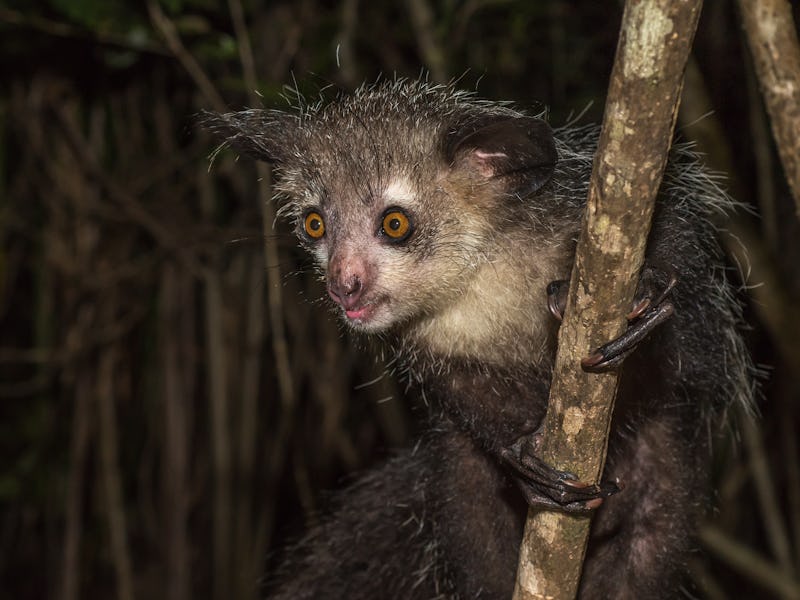This creepy lemur has been hiding something from us for a long time
“It really emphasizes how bizarre the aye-aye is, relative to other lemurs.”

With its spindly fingers and bat-like ears, the aye-aye already stands out from other lemurs. Now, researchers have found a bizarre feature that sets it apart from every other primate, too: a sixth finger.
The digit discovery is revealed in a study published Monday in the American Journal of Physical Anthropology.
“The initial reaction was more confusion than anything else,” Edwin Dickinson, Ph.D., a postdoctoral researcher at North Carolina State University and one of the paper’s co-authors, tells Inverse.
The research team found the hidden finger while studying a forearm muscle called the abductor pollicis longus in the tiny primate. As they followed the muscle from its forearm to its hand, they realized that one of its tendons splits in two — something they’d never seen in another primate.
At first, the researchers thought they might have an anomaly on their… hands. But after collecting more specimens — including male and female adults as well as a juvenile aye-aye — they could confirm the abnormality was in fact universal.
“Rather than just a really odd specimen, we’d discovered a really odd feature that was present across the species,” Dickinson says.
Odd features abound in the aye-aye, like its continuously growing incisors, a trait more commonly seen in rodents.
It’s also the only primate that uses echolocation, much like bats, to find its food. The nocturnal primate forages by tapping its long, slender middle finger against rotting logs, creating sound reverberations that helps it locate larvae, which it then fishes out with the same skinny finger.
The aye-aye's extra digit even has its own fingerprint.
The researchers believe the newly identified extra digit’s function is directly tied to the aye-aye’s already creepy finger situation.
“They’re almost not fingers anymore, they’re feeding tools,” Dickinson says. That works great for foraging, but the specialized fingers “basically make the hand kind of useless for everything else that a hand needs to do.”
So the aye-aye developed a pseudothumb, the researchers suggest, to help it hold objects and climb trees without falling. The digit consists of a small bone and cartilaginous extension, with three muscles that help it move in three different directions.
Researchers say the new discovery “really emphasizes how bizarre the aye-aye is, relative to other lemurs.”
The aye-aye’s pseudothumb has the same bone and muscular structure as that of a giant panda, perhaps the most famous example of a pseudothumbed animal. While the aye-aye’s over-specialized hands led to the need for a gripping finger, in the panda’s case, under-specialized paws necessitated the same feature.
So to recap, the aye-aye has a rodent’s teeth, bat’s ears, panda’s hands,Gremlin’s overall vibe —and yet it’s a primate, just like we are.
Finding the aye-aye’s specialty finger just solidifies its position as a “weirdo primate that’s nothing like a primate should be,” Dickinson says.
“It really emphasizes how bizarre the aye-aye is, relative to other lemurs.”
In a video explaining the findings, study primary investigator Adam Hartstone-Rose, Ph.D., says he started working with a lemurologist at the American Museum of Natural History at the age of 14. He calls the new discovery a “dream come true.”
“As somebody who’s been passionate about lemurs for a really long time, it’s super exciting to be able to find a piece of anatomy in a lemur,” Hartstone-Rose says. “And especially the weirdest lemur of all.”
Partial Abstract:
Objectives: Accessory digits have evolved independently within several mammalian lineages. Most notable among these is the pseudothumb of the giant panda, which has long been considered one of the most extraordinary examples of contingent evolution. To date, no primate has been documented to possess such an adaptation. Here, we investigate the presence of this structure within the aye-aye (Daubentonia madagascariensis), a species renowned for several other specialized morphological adaptations in the hand, including a morphologically unique third digit.
Results: A distinct pseudothumb, which consists of both a bony component (an expanded radial sesamoid) and a dense cartilaginous extension (the “prepollex”) was observed in all specimens. We demonstrate that this pseudodigit receives muscular attachments from three muscles, which collectively have the potential to enable abduction, adduction, and opposition. Finally, we demonstrate that the pseudothumb possesses its own distinct pad within the palm, complete with independent dermatoglyphs.